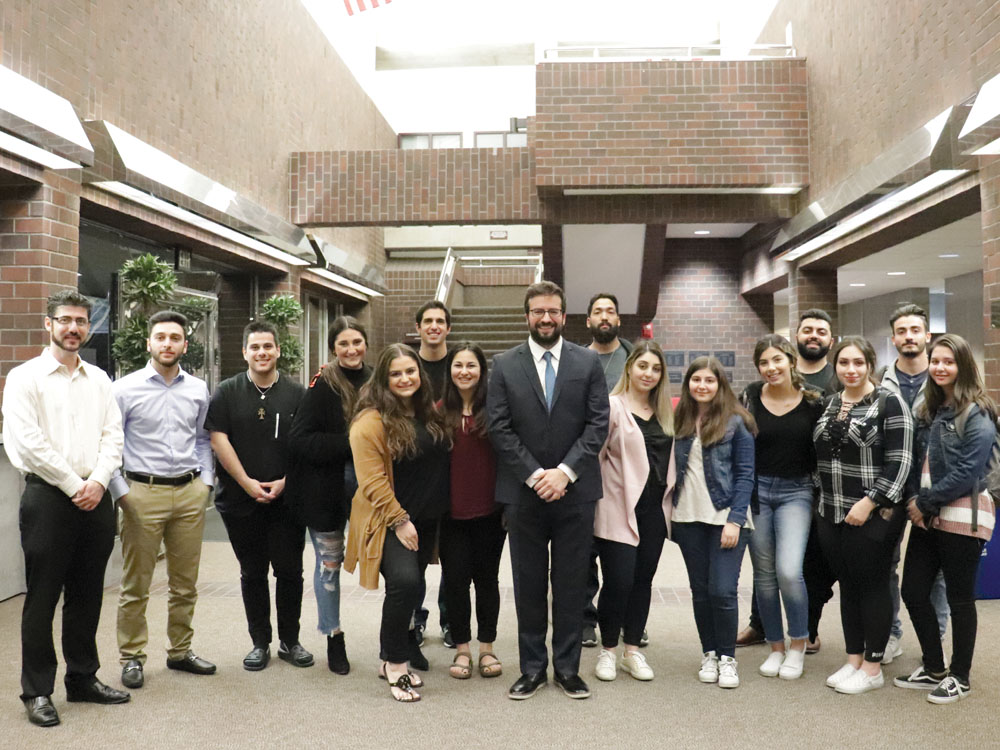
Photo: Andrew Hagopian
Carina Tokatian
Staff Writer
On Thursday, March 5, Dr. Ari Şekeryan spoke on the topic of “The Survivors: Armenian Orphans and Refugees After the First World War (1918-1923),” the second lecture of a three-part series on “Armenians in Istanbul during the Post Armistice Period.”
Dr. Şekeryan is the Kazan Visiting Professor in Armenian Studies for the Spring semester. A graduate of Oxford’s Department of Oriental Studies, he is currently working on a book, An Untold Story of Survival. In the 2018-2019 academic year, Dr. Şekeryan was an Honorary Fellow at the University of Wisconsin-Madison, Institute for Research in the Humanities.
The presentation was sponsored by the Armenian Studies Program and the Clara Bousian Bedrosian Fund, and was held in the University Business Center, Alice Peters Auditorium.
Dr. Şekeryan initially began his presentation by explaining his fascination with Armenians in Istanbul and Anatolia during the Armistice period of 1918-1923, which immediately followed World War I. He observed how scholars typically focus on outside relief organizations such as the American Near East Relief, the British Lord Mayor’s Refugee Fund, and the American Red Cross and their work in northern Syria and the Caucasus. However, the large Armenian population in Istanbul and the eastern provinces of the Ottoman Empire is often understudied. In fact, Dr. Şekeryan highlighted how the Istanbul Armenian com-munity itself donated almost $1 million in relief aid during the Armistice, an amount that exceeded donations collected from outside relief organizations.
Dr. Şekeryan stated that there were many Armenian orphans as a consequence of the Genocide. Some of these orphans, especially young boys, were driven from their homes and compelled to serve in Muslim families. Fortunately, the new Ottoman government, which succeeded the Committee of Union and Progress (CUP) in 1918, ordered the return of Armenian orphans and women to their families. The Armistice of Mudros also secured the right to search for these individuals and to return them to the Armenian community. In addition, influ-ential Armenian leaders such as Boghos Nubar Pasha encouraged the “unification and repatriation of refugees.” Eight refugee camps and ten orphanages were established in Istanbul to assist refugees from Anatolia. However, Dr. Şekeryan stated that these locations often contained unsatisfactory conditions. For example, there were sanitary issues and food shortages present in refugee camps. In orphanages, children sometimes slept on the floor and consumed only bread and tea, an insufficient diet lacking in protein. Nevertheless, orphanages sought to preserve the children’s Armenian identity, language, and culture. One or-phanage even held Olympic-like sports competitions for the children.
Identifying Armenian orphans posed a challenge in itself. Dr. Şekeryan labeled it as an “orphan hunting race” between Armenians and Turks to discover Armenian orphans. One particular orpha-nage, the Neutral House, sheltered children with unclear backgrounds for a ten-day period while its administrators attempted to learn their true identities. Some orphans were fearful of revealing their ethnicity because of threats they received from the Muslim families they were living with. In spite of this, administrators successfully identified some children by exposing them to Armenian lullabies or by their interactions with other Armenians. From these encounters, administrators could learn a child’s identity based on their reactions. As an example, Dr. Şekeryan mentioned how an orphan’s identity was often revealed by witnessing a priest making the sign of the cross.
To fundraise for the orphans, the Armenian community in Istanbul imposed its own tax on the Armenian community. Dr. Şekeryan specified how on some occasions, priests refused to perform religious ceremonies for Armenian families until they paid the tax. In addition, to gain support, Armenians were encouraged to adopt children or purchase expensive certificates as a way to harness a positive rivalry between the donors. Yet, not all Ottoman Armenians maintained a suitable income to support orphans and refugees as the “Horror in Tokat” proved. Inspired by Mustafa Kemal’s Turkish National Movement in 1919, Turks boycotted Armenian businesses in Tokat, and in other areas, leading to further impoverishment of the Armenian community. Dr. Şekeryan drew attention to similar boycotts toward Armenian businesses in Greece. These Armenian or-phans were sponsored by the Near East Relief organization and by Armenians in Istanbul, and were moved to Corfu, Greece. Unfortunately, when they arrived, they were met by Italian bombardment. Dr. Şekeryan noted how the Italians were informed of the group’s refugee status, yet, they still continued to shell the refugees. As a consequence, sixteen refugees were killed and three times this amount were wounded. The remainder of re-fugees continued to live and thrive in Greece, successfully establishing and managing their own businesses. Yet, boycotts interrupted this short-lived period of prosperity as Greeks pressured the large refugee population to move elsewhere.
Despite all that they endured as a result of the Genocide, Armenians in Istanbul proved determined to get back on their feet during the Armistice. Through their aid to orphans and refugees and resettlement across the globe their perseverance was clearly manifested.
 Hye Sharzhoom Armenian Action
Hye Sharzhoom Armenian Action